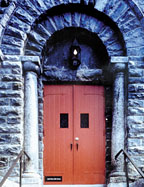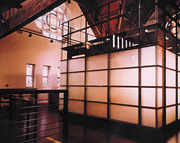

"The church was completed around the turn of the century," said Project Designer Mark Treon of Ziger/Snead in Baltimore, MD. "Half [of the building] was a sanctuary and the other half was used as a Sunday school. Between the two buildings was a space with big sliding doors." The designer explained that the church was built by a local architect, George C. Haskell, who had designed about 20 other buildings in the Baltimore area. "He was a notable architect for that time," said Treon.
According to the designer, the fire started on the first floor in the middle of the building. "The original fire damage was to the roof and a lot of stained glass," he said. "The fire blew out the stained glass, so the church was very open to the elements. A lot of rain and snow got in there, and birds were living in it."
In the fall of 1999, Gilden Integrated, a marketing agency dedicated to the technology industry, purchased the property from the Apostolic Truth Tabernacle congregation, which had occupied the building for 15 years. "The owner came to us and said that they wanted to use historic credits for the project," said Treon, explaining that to do this, the building either had to be in an historic area or on the National Register of Historic Places. Because the building met neither requirement, an historic consultant was hired to research the situation.
"We went with the argument that the building was designed by a famous local architect," said Treon. "That had a big impact in making the historic requirements." And once the building was recognized as an historic piece of architecture, that affected the way the restoration was handled, according to the designer.

Assessing the damage
The exterior of the building is believed to be comprised of a locally quarried Falls Road granite. "It definitely was very dirty," said Treon. "I don't know if it was ever cleaned in 100 years. There was a lot of grime on it and the mortar joints were in pretty bad shape." The architect explained that in past renovation work new mortar had been pressed on top of the original mortar instead of removing the original mortar first. In other areas, the mortar had gaping holes."We started to investigate how to clean the stone to meet the historic credits," said Treon. "We tried several cleaning methods and used the one which was least damaging to the stone. We tried three or four different scenarios -- starting with soap and water."
Treon said that they let the samples sit for a couple of weeks, while they determined what would be the most effective method of cleaning. In addition to considering what cleaned the stone the best, they also looked at how much time and effort each method required. "Simple water didn't take the dirt off," he said. In the end, SureKlean by ProSoCo was used to clean the granite.
The cleaning process took approximately four months to complete, according to Gary Cartwright of Coastal Exteriors, which was the subcontractor for the project. He explained that the walls were first wet down using 600 psi. The next step was to apply SureKlean to the granite and let it soak in for about three minutes. The walls were then sprayed down using 600 psi.
For the mortar, a spec had to be written that met the historic requirements. "We made sure nothing unusual like oyster shell was in the mortar," said Treon. "We repointed the entire front facade. On the other three facades we patched holes." According to Cartwright, a type N Flamigo mortar was used for the job.
It was believed that the granite was taken from a local quarry. "The contractor thought the granite was local from the Jones Falls area -- a mile or so from the church," said Treon. "There's a valley that runs through there." For the restoration, it wasn't necessary to use any new granite. "Anything that we replaced we used existing stone," said the architect. "We found stone in the basement that had fallen throughout the structure."
In total, a crew of about 10 worked on the restoration. Besides cleaning the granite exterior, they also replaced the roof with Vermont slate. The project was completed in June of this year.
Credit Box
Gilden Integrated Headquarters(formerly Grace-Hampden Methodist Episcopal Church)
Baltimore, MD
Owner: Gilden Integrated, Baltimore, MD
Architect: Ziger/Snead, Baltimore, MD
General Contractor: Hencken & Gains, Baltimore, MD
Subcontractor: Coastal Exteriors
Restoration Cleaning Products Supplier: ProSoCo, Lawrence, KS
